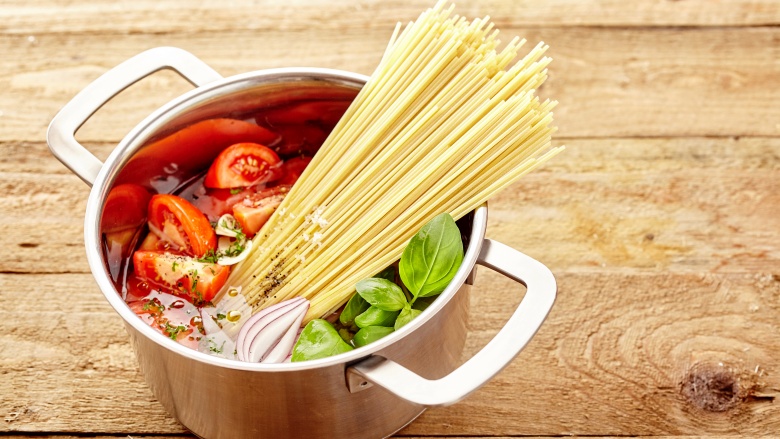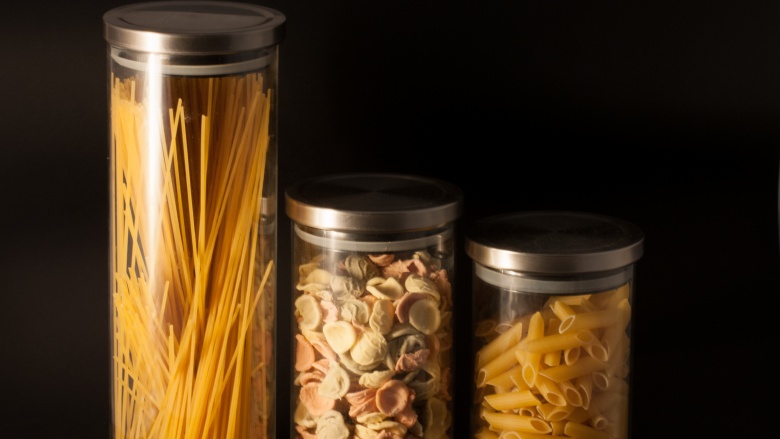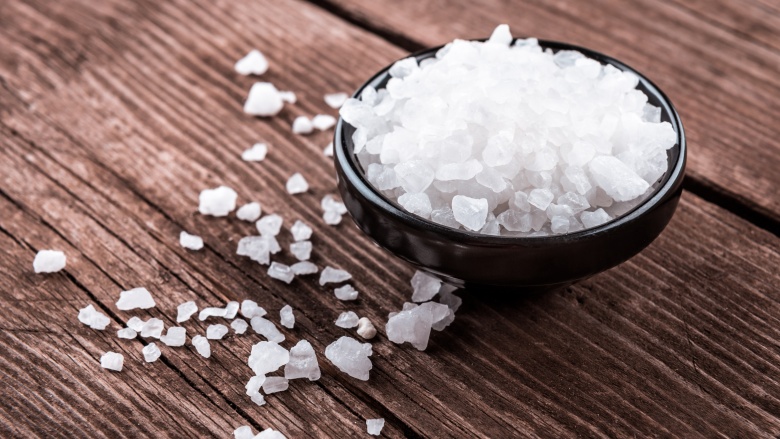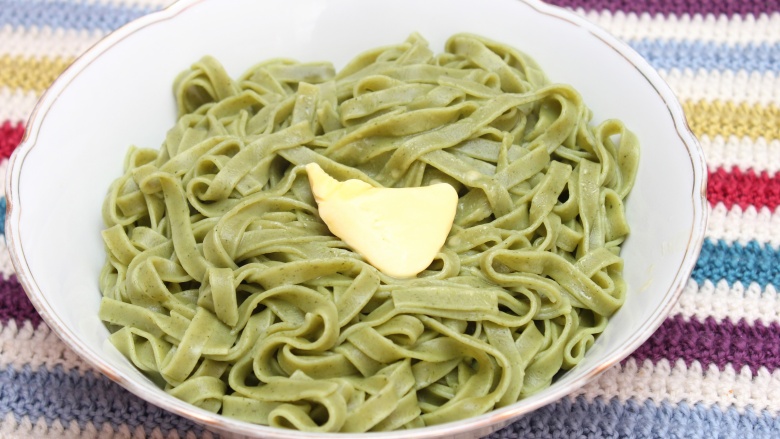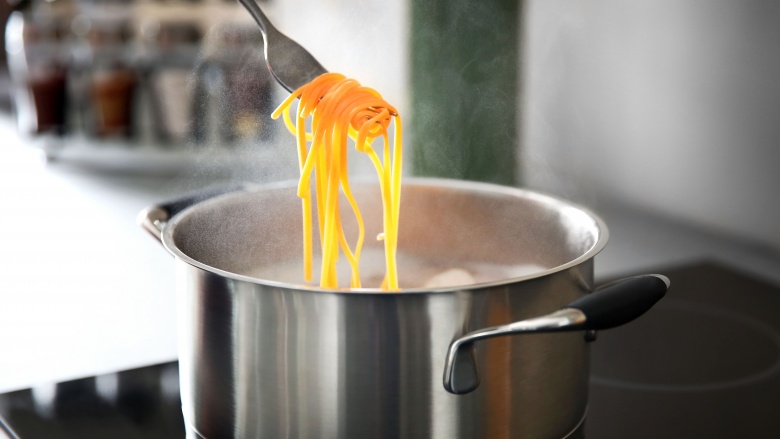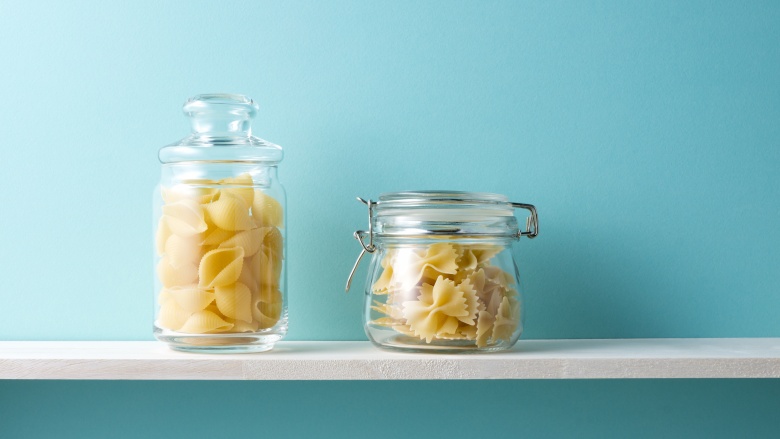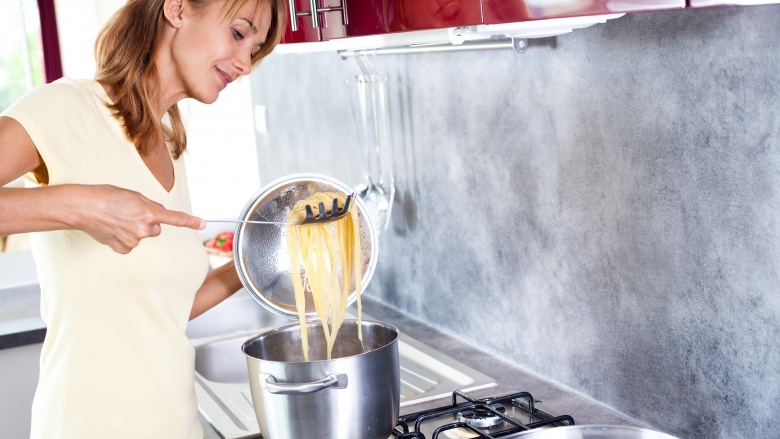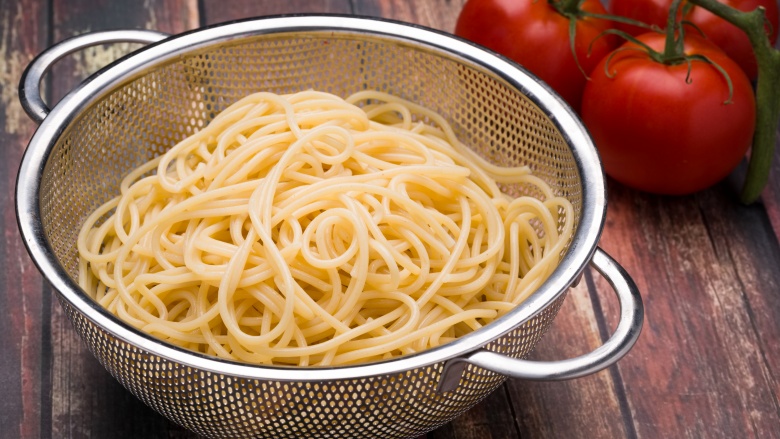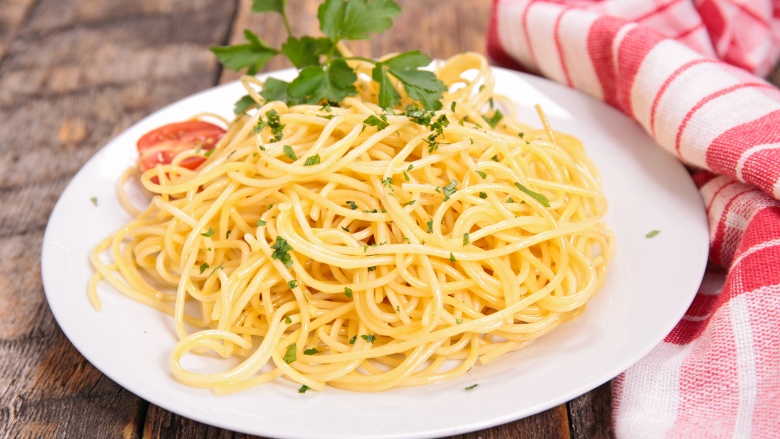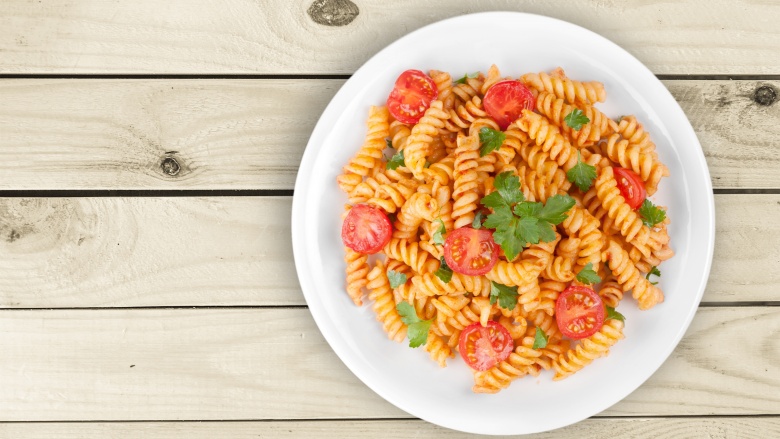10 Mistakes Everyone Makes When Cooking Pasta
There is nothing quite as comforting as a steaming plate of fresh pasta. It doesn't matter if it's covered with a rich tomato sauce or creamy alfredo — pasta is one of our favorite dishes. It's also easy to make. We've all had the experience of boiling water and tossing in some noodles. In fact, many of us probably survived on this in college. However, when it comes to pasta, your form matters. There's a big difference between light, al dente pasta and that gooey mess you sometimes end up with — and it all comes down to how you cook it. Here are some of the top pasta offenses and how to prevent them.
Your pot is too small
This is one of the most common mistakes. When cooking pasta, always reach for your largest pot and fill it with 5 to 6 quarts of water. Using a larger pot will keep you from having to break up the pasta to fit. It will also ensure your pasta doesn't come out sticky. Iron Chef Michael Symon shared his tips for perfect pasta with Real Simple. "When you add pasta to a small amount of water, it lowers the temperature of the water substantially more than if you added it to a large amount of water, so the water will take longer to return to a boil," he explains. "In the meantime, the pasta will sit at the bottom of the pot and start to clump up and become mushy unless you are vigilant about stirring,"
When you use a smaller pot, the pasta has less water to cook in. This results in a higher amount of starch in the pot, which will cause your pasta will to come out sticky after you drain the water. To be safe, always go for a big pot, even if you're only cooking a small amount of pasta.
You blindly follow directions
Any box of pasta you buy will have directions on the back. While these directions can be helpful, don't think of them as written in stone. Associate food editor at Good Housekeeping, Sherry Rujikarn reminded readers we should always follow our instincts when it comes to cooking perfect pasta. Don't stop cooking it just because the box said it should be cooked for 10 minutes. "Think of the time listed as a suggestion, not the gospel," Rujikarn explains. "After cooking more than a thousand pots of pasta, I'd say the box is accurate only about 50 percent of the time." Rujikarn said our pasta can often be completely undercooked when the cooking time is up, so always taste a noodle or two before draining the pot. According to her, it's always safer to keep cooking your pasta until it's cooked, but still firm. "Depending on how undercooked it is, you'll want to continue in 30-second to one-minute intervals, tasting along the way," she recommends. "Remember, you can always continue cooking, but you can't undo a mushy noodle."
You leave out the salt
If you read the back of your box of pasta, it will tell you to boil the pasta in salted water. Maybe it's because we're all trying to eat a little healthier, or maybe it's just pure laziness, but many of us skip that step. I've been guilty of this in the past and had no idea that by omitting the salt, I was opting for slimy pasta.
Assistant food editor Kelly Foster explained to The Kitchn why salt is so important. "When I was in culinary school, our chef's rule of thumb was that the water should be as salty as the sea," she shared. "That may be a little on the extreme side, but pasta water certainly needs more than just a pinch of salt." And don't worry about your sodium levels. The pasta won't absorb most of the salt, it just roughens up the noodles so they don't get slimy. Foster recommends adding 1 to 2 tablespoons of salt for every 5 to 6 quarts of cooking water.
No time to measure? No problem, just go by this guideline from Good Housekeeping's associate food editor, Sherry Rujikarn. "My personal rule of thumb is to throw in a small palmful of salt for 1 pound of pasta in a 7- or 8-quart pot," she recommends. "No need to worry about using that much salt, most of it will be going down the drain anyway."
You add too much fat
Some fresh pasta with brightly colored vegetables is a healthy dish any Italian would be proud to serve. Unfortunately, in the United States, we often douse our pasta with creamy Alfredo sauce or imitation cheese. That fat we add to our pasta won't just increase our waistlines, either. It actually takes away some of your pasta's naturally-delicious starchy flavor.
Make sure you don't add any oil to your pot of cooking pasta. The oil will cause the noodles to become slippery, which means whatever sauce you add won't stick to them, resulting in plain, tasteless noodles. Chef Mario Batali says there's nothing wrong with adding some fat to your pasta, but you have to do it the right way. For example, when using a butter sauce, make sure to keep it cold. "When finishing a pasta with a butter sauce," he explains. "Use a cold butter for a better emulsion."
You forget to stir
Once your water is boiling, be sure to stir your pasta in, as opposed to just dumping it and waiting until it's cooked. Chef Lidia Bastianich told Today it's crucial to stir your pasta so it doesn't all sink to the bottom of the pot. When your noodles are all resting at the bottom of the pot, they can start sticking together, resulting in gummy pasta. No thank you!
"Mixing the pasta periodically will help keep it from sticking together," explains Bastianich. "When you're making a long pasta, you really want to spread it around the pot and then it will slowly sink into the water." If you have long noodles, it can be tempting to break them up or force them all into the water at once. Rather than stuffing your pasta into the pot to make it fit, allow the longer noodles to stand up in the pot and sink down as they cook. Then just make sure to give them a stir so every piece cooks evenly.
You throw your pasta against the wall
If you've ever had trouble telling if your pasta was finished cooking, maybe you felt tempted to try the old trick of throwing it against the wall. Supposedly, if the pasta sticks to the wall once it's thrown, you're good to go. Well not to be a downer, but that is a huge cooking mistake. Not only are you wasting some delicious pasta and dirtying your walls (not to mention teaching your kids some questionable habits) — but it doesn't actually work.
Cookbook author Marcella Hazan told Rachel Ray that trick is purely a myth. "The only way to know if it's done is to taste it! It should be al dente, or firm to the bite," she explains. "The more pasta cooks, the gummier it gets, so if it sticks to the wall it's probably overdone."
You toss the cooking water
Once your pasta is cooked, hang on to a cup or so of the cooking water. This water is now starchy and full of pasta flavor, and it just might come in handy. Associate food editor Sherry Rujikarn shared with Good Housekeeping that keeping some of this magical water on hand is always a good idea. "You probably won't need it for super saucy preparations (think marinara or bolognese), but for anything that's a bit drier (like olive oil-based sauces) or creamier, adding a splash or two of cooking water is the perfect way to take clumpy and dry sauce to luxurious and silky," she explained. "The water helps loosen up the sauce so it can coat every noodle, while the starch in the water helps it cling to the pasta better."
You rinse the pasta
Hey there go-getter, don't make this harder than it needs to be. Cooking pasta is one of the easiest ways to throw together a delicious, home-cooked meal, so don't add any extra steps. There's no need to rinse your pasta with water once it's cooked. Simply drain it and add your sauce.
Chef Lidia Bastianich told Today that while we never want sticky pasta, the noodles can't be too smooth. We still want our sauce to stick to them, so rinsing strips your pasta of some of that starchiness that will cling to the sauce. "When the pasta is done, put it right into the sauce," recommends Bastianich. "I finish cooking the pasta in the sauce until the al dente texture goes away, and it absorbs the sauce and the pasta is ready to go."
You make way too much
Judging how much dry pasta to toss in your pot can be tricky, especially when you're cooking for a crowd. I'm usually so afraid of running out that I cook the entire box and have piles of leftovers. The trouble is, heating up leftover pasta usually results in a sticky, gummy mess. When it comes to pasta, fresh is best, so don't waste that decadent treat by cooking way too much then throwing it away. Barilla recommends cooking two ounces of dry pasta per dinner guest.
Cookbook author Lisa Lillien shares tips for quickly measuring pasta servings on her blog Hungry Girl. And don't worry, no food scale or complicated measuring tools needed. "A 2-ounce serving of uncooked elbow macaroni comes to just shy of 1/2 cup," explains Lillien. "The same amount of dry penne measures in at a little more than 1/2 cup."
You leave your pasta waiting
Cookbook author Marcella Hazan shared with Rachel Ray that our pasta needs to be served as soon as it's cooked. "Pasta must never be made to wait," she shares.
While your pasta cooks, make sure to have a colander ready in the sink so you can drain it as soon as it's cooked. Once it's drained, place your pasta in a warmed bowl and toss with warm sauce. This is also a great time to toss in a splash of that starchy cooking water. Once it's ready to go, serve it right away. Your family (and your pasta) will thank you.

